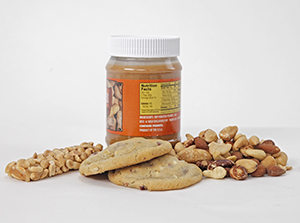In a Nutshell: Understanding Peanut Allergies
Peanuts are tasty treats. But they also can set off serious allergic reactions in some people. If your child is allergic to peanuts, here’s what you need to know.

Signs of a peanut allergy
Despite its name, the peanut isn’t a nut at all. It’s actually a legume. Legumes are plants that grow underground. The group includes beans, peas, and lentils.
Peanuts may not seem to have much in common with milk, eggs, or wheat either. But like these foods, they are at the top of the food allergy list. Even the slightest trace of a peanut can cause a reaction in children who are allergic to them. And more and more children seem to be developing this serious food allergy.
Your child may be allergic to peanuts if they have these symptoms after eating or coming into contact with them.
Call your child's healthcare provider right away for common symptoms, such as:
Call 911 for more serious symptoms, or for a severe, possibly life-threatening allergic reaction (anaphylaxis). Serious symptoms include:
-
Trouble breathing, talking, swallowing, or drooling
-
Any change in level of alertness or unconsciousness
-
Cool, moist, or pale (or blue in color) skin
-
Fast heartbeat or weak pulse and feeling weak
-
Wheezing, coughing, or shortness of breath
-
Feeling lightheaded or confused or dizzy
-
Very drowsy or has trouble waking up
-
Swelling of the tongue, face, or lips
-
Nausea, vomiting
-
Diarrhea, belly pain, or stomach cramps
-
Seizure
-
Chest pain or tightness
Steps for managing the allergy
Many children develop a peanut allergy early in life. Tests can help find out if your child has a peanut allergy. A common one is a skin prick test. Your child’s healthcare provider will scratch your child’s skin with a small amount of peanut extract. If your child’s skin becomes red and swollen in the test area, a peanut allergy is likely.
It’s important to know that your child may test positive for a peanut allergy but not have a reaction when they eat peanuts. Food allergy tests (both skin tests and blood tests) may have "false positive" results. This mean that the test is positive for food allergy, but your child can eat the food without any issues. This may happen if your child has certain seasonal allergies or bad eczema. The healthcare provider will use the test results, a physical exam, and your child's history of reactions and exposures to help find out if a peanut allergy is likely.
Unfortunately, a peanut allergy can’t be cured. And few children outgrow it. So staying away from peanuts and foods that contain them has long been the key strategy for managing the allergy. Many different foods can have peanuts or peanut residue in them. Peanuts can hide in foods, such as baked goods, salad dressings, chili sauce, candy, and even pet food.
An oral immunotherapy medicine is now available to treat peanut allergy in children. It can help reduce the severity of allergic reactions. The FDA-approved medicine is for children and teens ages 1 to 17. A child with a confirmed peanut allergy can start taking the medicine at age 1. Talk with your child’s healthcare provider to find out if this medicine can help your child. If your child is taking this medicine, continue to make sure they don’t eat any peanuts or peanut products.
To help protect your allergic child, follow these tips:
-
When grocery shopping, check every item’s food label for peanuts. Check the label even if your child has eaten that food in the past.
-
Tell all restaurants and servers about your child's food allergy.
-
Always keep medicine on hand. Epinephrine can help stop a severe allergic reaction. Ask your child's healthcare provider if they epinephrine medicine, such as an auto-injector or nasal spray. Make sure that you understand when and how to use this medicine.
-
Work with your child’s healthcare provider to create a care plan in case of an emergency.
-
If your child has a serious allergy, have them wear a medical alert bracelet that notes this allergy.
-
Tell all care providers and school staff about your child's allergy. Show them how to use any prescribed medicine.
-
For a life-threatening allergy, make certain that onsite school staff know how to give epinephrine to treat a severe reaction. After using epinephrine, the child should be transported to the ER and stay there for observation because symptoms may return. Have an emergency response kit with written instructions available at all times. This includes during recess and on field trips.
Can you help prevent a peanut allergy in your child?
Newer research suggests you may be able to help prevent a peanut allergy, mainly in young children at high risk for it. Babies who are at high risk for the allergy include those who already have other food allergies. Or babies who have the skin condition eczema.
Introducing peanut-containing products in the first year of life (4 to 6 months) may help prevent the allergy. For some children, it is advised to do testing before introducing peanuts. For other children, testing is not needed. Talk with your child’s healthcare provider first to see what is right for your child. Never give any child younger than age 4 whole or partial peanuts. They can be a choking hazard.